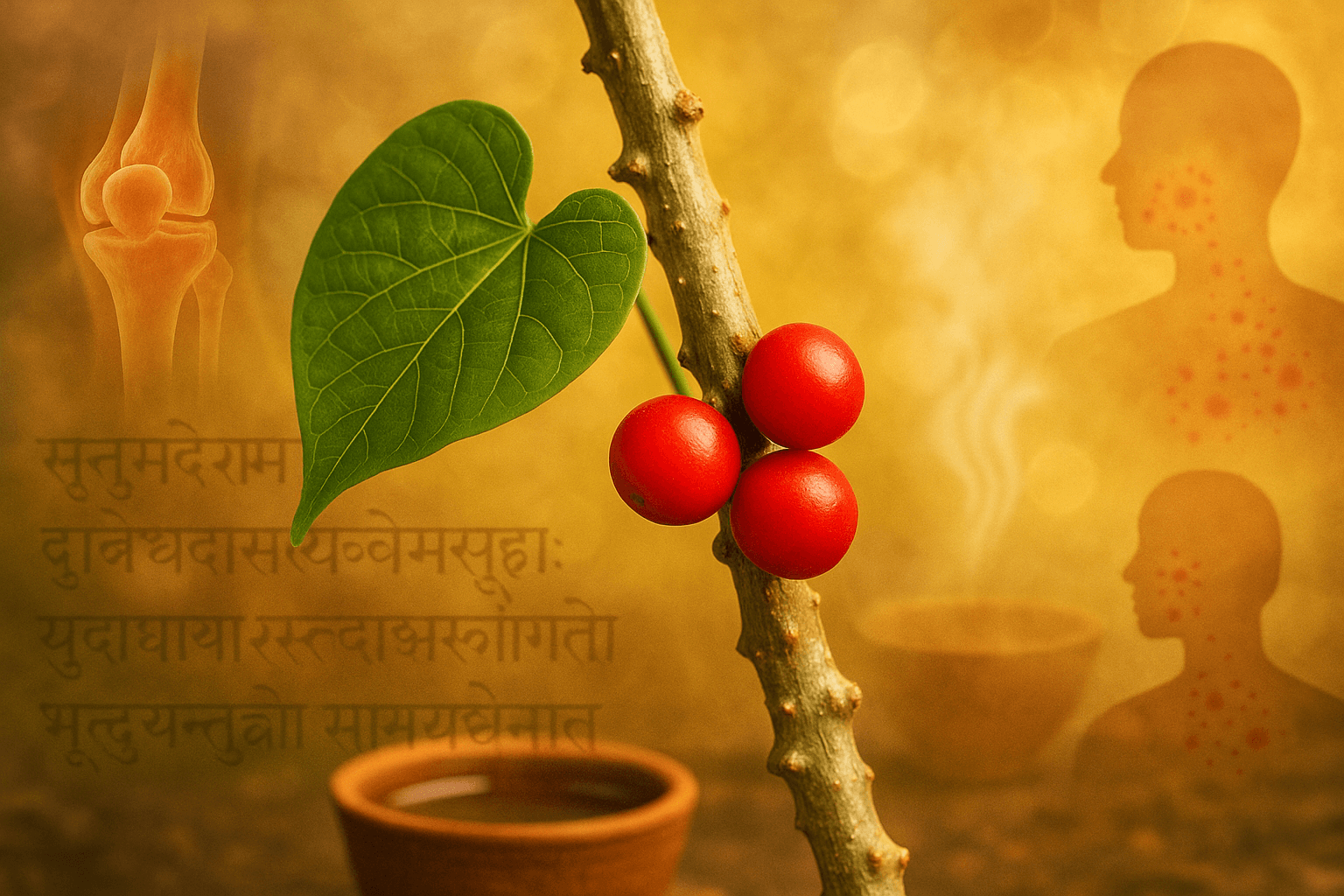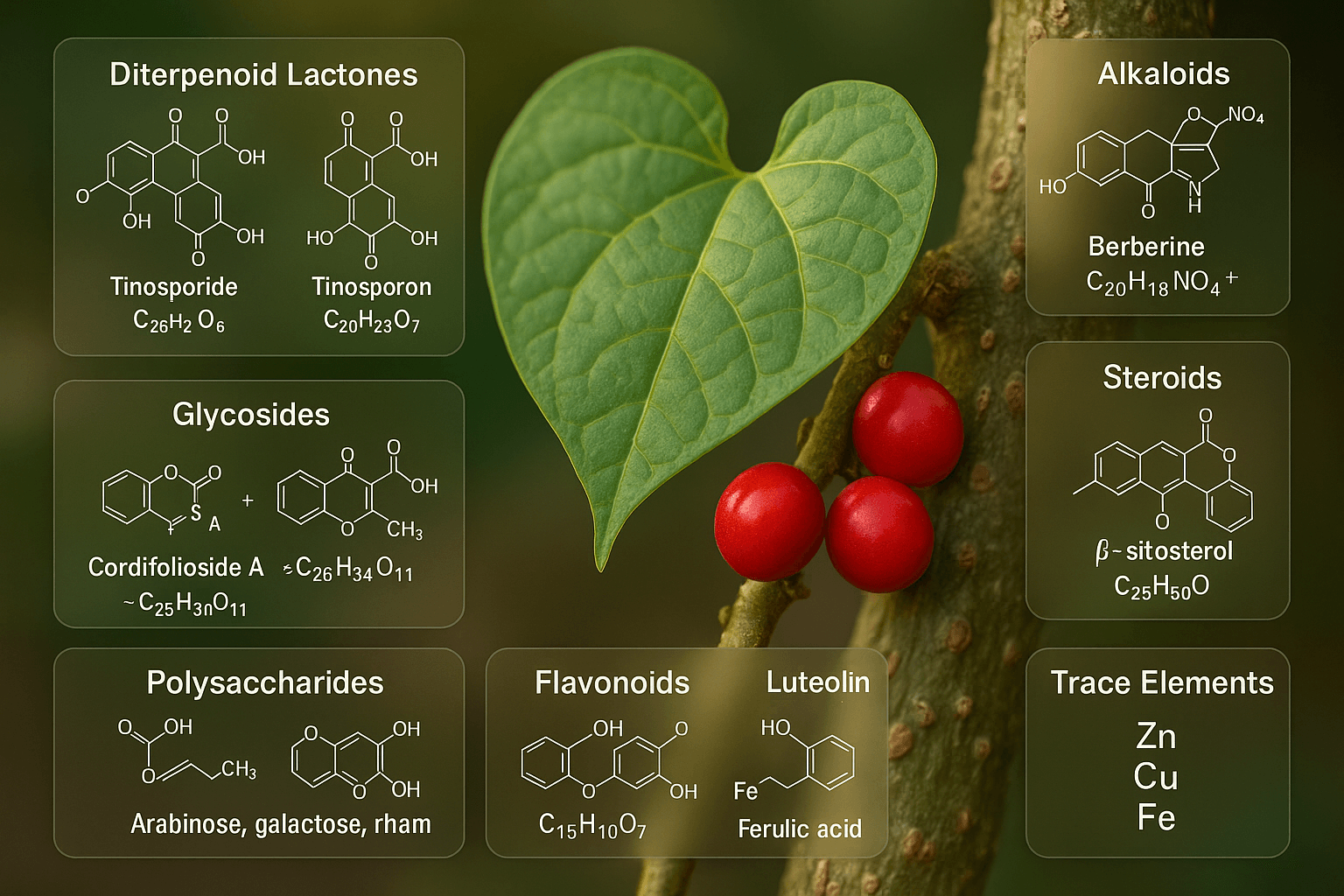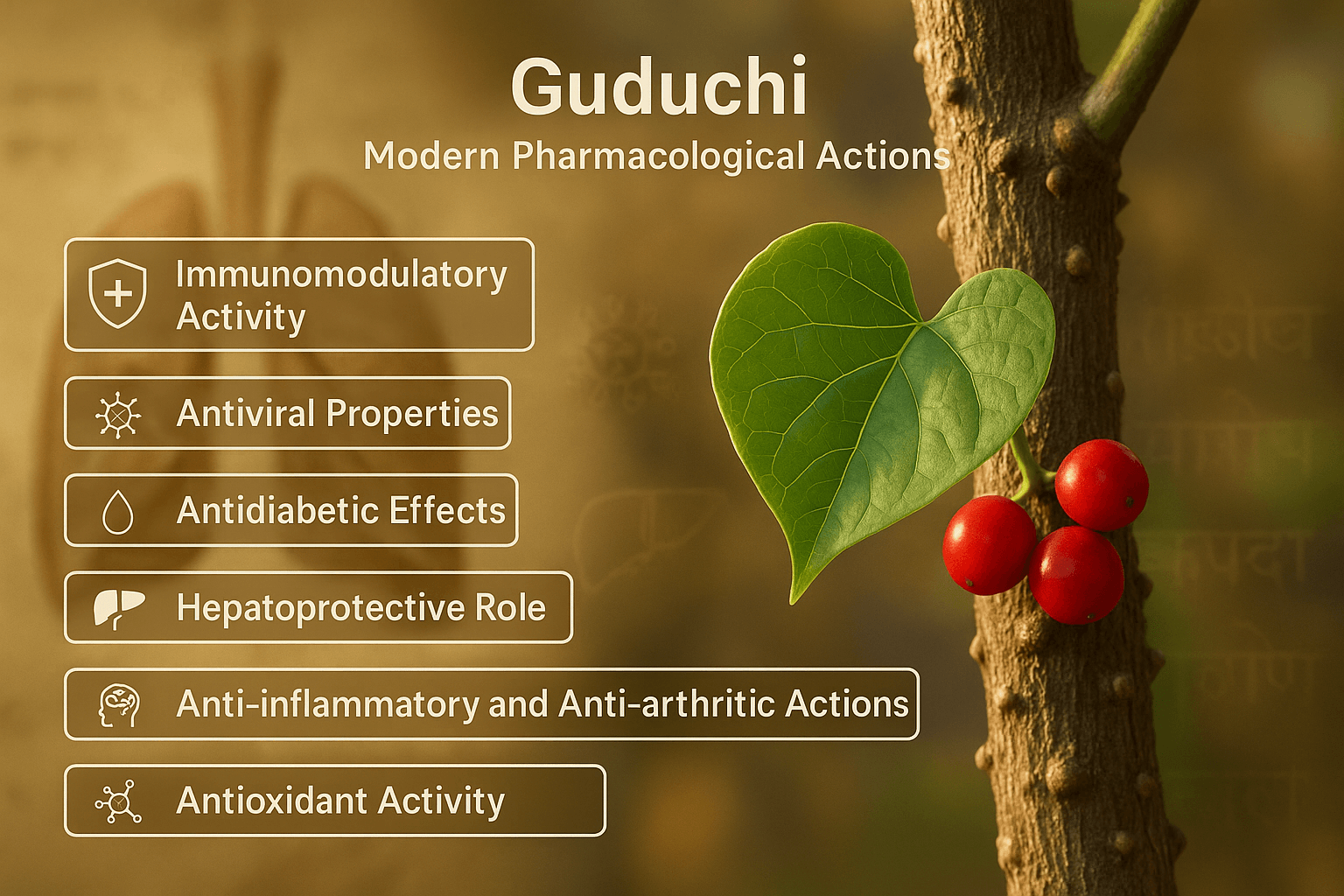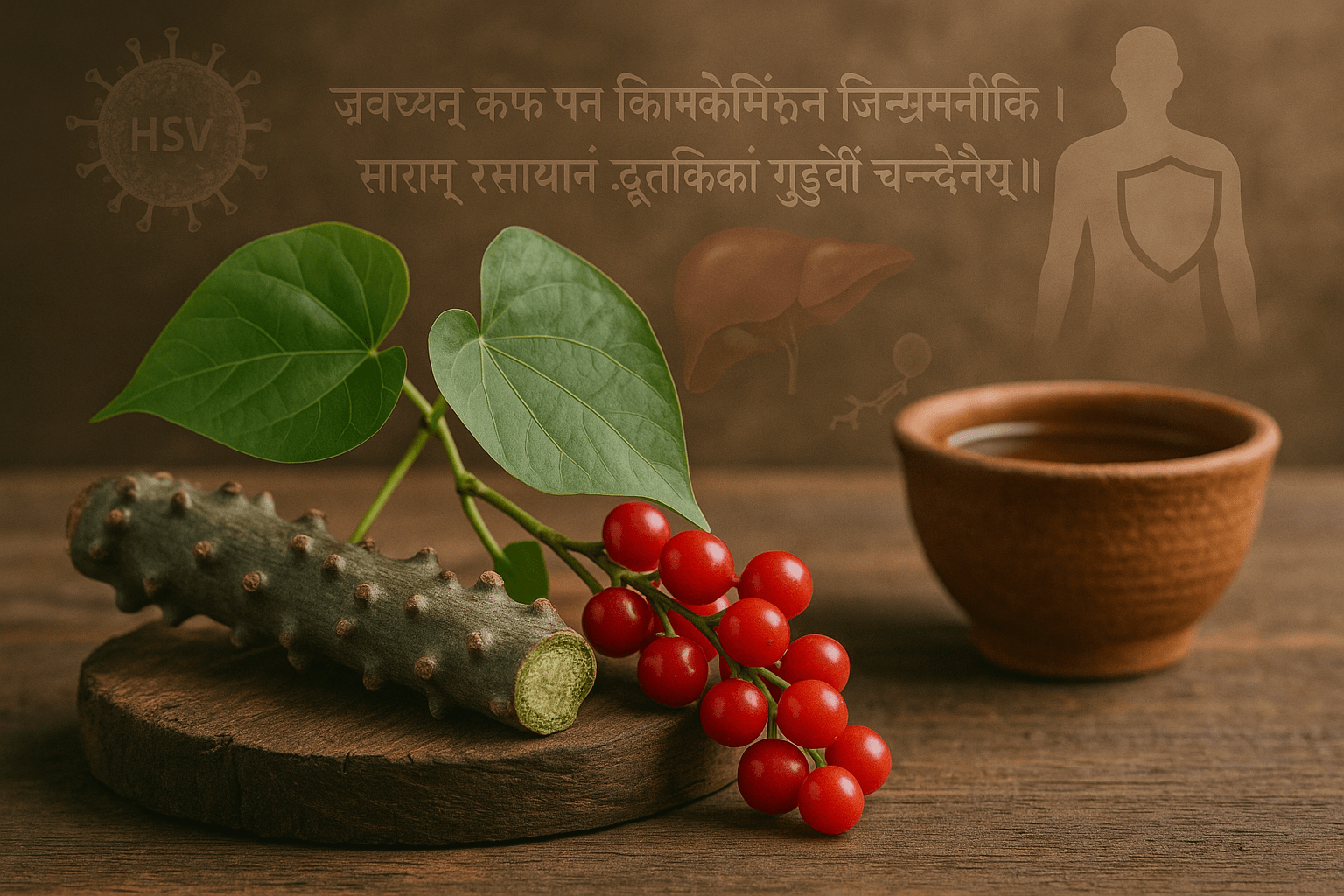Guduchi, scientifically known as Tinospora cordifolia, is one of Ayurveda’s most celebrated Rasayana herbs, revered for its ability to enhance longevity, immunity, and resilience against disease. Its Sanskrit name “Amrita” literally means “nectar of immortality,” highlighting its life-prolonging and disease-preventing qualities as described in the Charaka Samhita (Chikitsa Sthana 1/3, p. 378, Chaukhambha edition) [1]. This climbing shrub is widely used in formulations for fever, metabolic disorders, skin diseases, and viral infections, and is mentioned in the Sushruta Samhita (Uttara Tantra 39/49) as a key remedy for chronic fevers and immunity depletion [2]. Modern pharmacological research confirms its adaptogenic, immunomodulatory, and antiviral properties, making it a potent candidate for integrative medicine [3].
Botanical Description and Distribution
Tinospora cordifolia belongs to the family Menispermaceae and is a large, glabrous, deciduous climbing shrub. The stem is succulent with long filiform aerial roots emerging from mature nodes. Leaves are heart-shaped (cordate) with a smooth texture and alternate arrangement, and small yellow flowers appear during the summer. Fruits are fleshy, single-seeded drupes that turn red upon ripening. Guduchi thrives in tropical and subtropical climates, occurring abundantly throughout India, Myanmar, Sri Lanka, and parts of Africa. Ayurvedic texts recommend harvesting the stem during Sharad Ritu (autumn) for maximum potency, as noted in Bhavaprakasha Nighantu (Haritakyadi Varga, shloka 191–193, p. 275) [4].
Ayurvedic Classification
In Ayurvedic pharmacology, Guduchi is classified as follows:
- Rasa (Taste): Tikta (bitter), Kashaya (astringent)
- Guna (Qualities): Laghu (light), Snigdha (unctuous)
- Virya (Potency): Ushna (hot)
- Vipaka (Post-digestive effect): Madhura (sweet)
It is Tridoshahara, meaning it balances all three Doshas—Vata, Pitta, and Kapha—but is particularly effective in pacifying Pitta and Kapha disorders. It nourishes Rasadhatu (plasma) and strengthens Ojas, the vital essence responsible for immunity, while purifying Raktadhatu (blood) and regulating Meda Dhatu (fat tissue).
The Charaka Samhita (Sutra Sthana 25/40, p. 138) lists Guduchi among the Medhya Rasayana—herbs that enhance intellect and mental clarity [5]. The Ashtanga Hridaya (Chikitsa Sthana 1/25, p. 45) describes its Amapachana (detoxifying) and Jwaraghna (antipyretic) qualities, noting its role in restoring digestive fire (Agni) after prolonged illness [6].
Classical Therapeutic Indications

Guduchi is among the most extensively described herbs in the Ayurvedic canon, mentioned in multiple authoritative texts for its broad-spectrum therapeutic utility. The Charaka Samhita (Chikitsa Sthana 3/30, p. 389) prescribes Guduchi as a principal Rasayana for Jirna Jwara (chronic fever) and Santapa (persistent low-grade heat in the body), where its bitter-astringent taste and Ushna Virya help clear residual toxins while stimulating Agni (digestive fire) [7]. This makes it especially valuable in cases of post-febrile syndrome, a condition now recognized in modern medicine as post-viral fatigue.
The Bhavaprakasha Nighantu (Haritakyadi Varga, shloka 191–193, p. 275) describes its role in Pandu (Ayurvedic equivalent of anemia) through blood purification and enhancement of nutrient assimilation, in Prameha (a group of disorders correlating with type 2 diabetes and metabolic syndrome) by improving insulin sensitivity, and in Kushtha (skin disorders) where its detoxifying and anti-inflammatory actions alleviate chronic dermatological conditions [8].
Sushruta Samhita (Uttara Tantra 39/49) emphasizes Guduchi’s use in fevers of unknown origin and post-infectious debility, prescribing it as a restorative tonic to replenish Ojas—the subtle essence of all Dhatus responsible for immunity and vitality [9]. In Amavata (rheumatoid arthritis), Guduchi’s Amapachana (toxin-metabolizing) capacity removes circulating inflammatory complexes, reducing joint pain and swelling [10].
For Krimi Roga (parasitic and microbial infections), Guduchi is documented as both Krimighna (antimicrobial) and Rasayana, a rare dual action that not only eliminates pathogens but also restores tissue integrity [11]. In Shotha (inflammatory swellings), especially those secondary to infection, it is combined with Shunthi (Zingiber officinale) and Haridra (Curcuma longa) to enhance lymphatic drainage and reduce edema.
Notably, in Kushtha of viral origin—conditions now identified as herpes simplex, varicella, and other dermatotropic viruses—Guduchi is paired with Neem (Azadirachta indica), Manjistha (Rubia cordifolia), and Turmeric to break the inflammatory cycle, aid lesion healing, and prevent recurrence [12].
This wide range of classical applications shows Guduchi’s adaptability across multiple Vyadhi (disease categories), with mechanisms that align with modern immunomodulatory, antiviral, antidiabetic, and anti-inflammatory actions.
Phytochemistry and Active Constituents

Diterpenoid Lactones
Guduchi is rich in diterpenoid lactones such as tinosporide (C₂₀H₂₄O₈), tinosporon (C₂₀H₂₂O₇), cordifolide (C₂₀H₂₄O₉), and tinosporic acid (C₂₀H₂₂O₁₀). These compounds are well-documented for their immunomodulatory and anti-inflammatory activity. Tinosporide, for example, downregulates pro-inflammatory cytokines like TNF-α and IL-6, which are elevated in chronic inflammatory states [13]. In daily life, this translates to faster recovery from viral fevers, reduced swelling in joint disorders, and better resilience against seasonal infections when Guduchi is consumed as decoction or Satva extract.
Alkaloids
Major alkaloids include berberine (C₂₀H₁₈NO₄⁺), magnoflorine (C₂₀H₂₄NO₄⁺), and palmatine (C₂₁H₂₂NO₄⁺). Berberine is known for its antimicrobial, antiviral, and antidiabetic effects, while magnoflorine acts as a neuroprotective and adaptogenic compound. In practical terms, Guduchi tea or Kwatha taken daily can help maintain blood sugar balance, support brain function, and provide mild protection against gut infections, especially in people with weak digestion [14].
Glycosides and Steroids
Guduchi’s glycosides modulate immune signaling pathways, while its steroidal constituents—structurally similar to endogenous corticosteroids—exhibit hepatoprotective properties. By stabilizing hepatocyte membranes and reducing lipid peroxidation, they safeguard the liver during prolonged medication use or after toxin exposure. A common home practice is combining Guduchi decoction with a teaspoon of honey post meals to support liver health and digestion [15].
Polysaccharides
Guduchi contains rhamnose-rich polysaccharides and arabinogalactan, which are complex carbohydrates that boost immune cell function. These molecules enhance macrophage activity, stimulate nitric oxide synthesis (NO), and improve phagocytic clearance of pathogens. Regular use of Guduchi in powder form (3–5 g with warm water) can gradually improve immune strength, especially in recurrent throat or sinus infections [16].
Phenolics and Flavonoids
Key antioxidants in Guduchi include quercetin (C₁₅H₁₀O₇) and luteolin (C₁₅H₁₀O₆), along with phenolic acids like ferulic acid (C₁₀H₁₀O₄). These compounds neutralize reactive oxygen species (ROS), slowing cellular damage and supporting cardiovascular health. In daily diet, Guduchi juice mixed with Amla (Phyllanthus emblica) juice is a potent morning tonic for anti-aging and metabolic health [17].
Trace Elements
Minerals such as zinc (Zn), copper (Cu), and iron (Fe) occur in bioavailable forms in Guduchi, assisting in enzymatic reactions, oxygen transport, and immune regulation. Their presence explains why long-term Guduchi supplementation can improve hemoglobin levels and reduce fatigue in anemic individuals [18].
The synergy of these bioactive compounds explains why Guduchi can simultaneously modulate immunity, detoxify the liver, protect against infections, and enhance vitality—qualities that make it relevant for both chronic disease management and preventive healthcare in daily life.
Modern Pharmacological Actions

Immunomodulatory Activity
Multiple clinical and experimental studies confirm Guduchi’s ability to modulate both innate and adaptive immune responses. Its polysaccharide fractions stimulate macrophage activation, enhance phagocytosis, and increase cytokine production such as IL-1β and IFN-γ [19]. These immune-enhancing effects align with its classical Rasayana designation and explain its utility in preventing recurrent respiratory and gastrointestinal infections. In a randomized controlled trial involving patients with allergic rhinitis, Guduchi extract significantly reduced nasal symptoms and improved eosinophil counts compared to placebo [20].
Antiviral Properties
Guduchi has demonstrated inhibitory effects against several viruses, including herpes simplex virus (HSV), hepatitis B virus (HBV), and SARS-CoV-2 in in-vitro studies [21]. Mechanistic studies suggest that its diterpenoid lactones interfere with viral replication by modulating host cell signaling pathways, while its polyphenols reduce oxidative stress in infected cells. In combination with Neem and Turmeric, Guduchi formulations have shown clinical improvement in patients with recurrent herpes labialis [22].
Antidiabetic Effects
Guduchi extract has been shown to reduce fasting blood glucose and HbA1c levels in type 2 diabetes patients. Its alkaloid berberine enhances insulin sensitivity by activating AMP-activated protein kinase (AMPK) pathways [23]. Animal studies confirm that aqueous Guduchi extracts improve pancreatic β-cell function and reduce oxidative stress markers [24].
Hepatoprotective Role
Steroidal components in Guduchi protect liver tissue from chemical and drug-induced toxicity. Experimental models of paracetamol-induced hepatotoxicity showed that Guduchi treatment restored liver enzyme levels (AST, ALT) and reduced histopathological damage [25]. Its antioxidant properties also counteract lipid peroxidation in hepatocytes.
Anti-inflammatory and Anti-arthritic Actions
Guduchi reduces joint swelling, pain, and stiffness in rheumatoid arthritis patients, as documented in a double-blind clinical study [26]. The anti-inflammatory effect is mediated through inhibition of COX-2 and downregulation of NF-κB signaling. In Ayurvedic practice, it is frequently combined with Guggulu (Commiphora mukul) for chronic inflammatory conditions.
Neuroprotective Potential
Animal studies indicate that Guduchi extracts enhance memory retention, reduce neuronal oxidative stress, and protect against β-amyloid-induced toxicity, suggesting possible benefits in Alzheimer’s disease [27]. These effects are linked to magnoflorine and quercetin, which improve synaptic plasticity and reduce neuroinflammation.
Antioxidant Activity
Guduchi’s phenolic and flavonoid content confers strong free radical scavenging ability. In human studies, supplementation increased serum antioxidant capacity and lowered markers of oxidative stress such as malondialdehyde (MDA) [28]. This antioxidant defense supports its anti-aging and cardiovascular protective claims in Ayurveda.

Ayurvedic Perspective
In classical Ayurvedic texts, Guduchi is mentioned as Jwaraghna (fever-reducing), Krimighna (antimicrobial), and Rasayana (rejuvenative), making it particularly suited for disorders now recognized as viral in nature. The Charaka Samhita (Chikitsa Sthana 3/30, p. 389) advises Guduchi as a frontline herb in Vishamajwara (recurrent fevers) and Aupasargika Vyadhi (communicable diseases), where it not only addresses the root cause but also strengthens Ojas to prevent recurrence [29]. Bhavaprakasha (Haritakyadi Varga, shloka 191–193, p. 275) lists Guduchi in combination with Neem (Azadirachta indica) and Amalaki (Phyllanthus emblica) for skin eruptions and systemic infections [30].
Modern Virological Findings
Guduchi’s antiviral activity has been validated in multiple experimental models. Extracts have shown inhibitory effects on herpes simplex virus type 1 (HSV-1) and type 2 (HSV-2) by interfering with viral attachment and replication phases [31]. In hepatitis B virus (HBV) studies, Guduchi’s diterpenoid lactones suppressed viral antigen expression and reduced viral DNA replication in hepatocytes [32].
In the context of SARS-CoV-2, in-vitro studies indicate that ethanolic Guduchi extract may inhibit spike protein binding to ACE2 receptors and reduce inflammatory markers like IL-6 and CRP [33]. While clinical trials are still limited, early data suggest its role as a supportive immune modulator during viral outbreaks.
Integration with Other Herbs
Ayurvedic formulations often pair Guduchi with antiviral botanicals to create synergistic effects:
- For Herpes and Varicella – Guduchi with Neem, Turmeric (Curcuma longa), and Manjistha (Rubia cordifolia) for lesion healing and recurrence prevention [34].
- For Hepatitis and Liver-supportive Therapy – Guduchi with Bhumyamalaki (Phyllanthus niruri) and Katuki (Picrorhiza kurroa) to reduce viral load and improve liver enzyme profiles [35].
- For Immunity in HIV/Chronic Viral Conditions – Guduchi with Ashwagandha (Withania somnifera) and Amalaki to boost CD4 count and reduce opportunistic infections [36].
Clinical Relevance
A clinical study on HSV patients receiving Guduchi-based polyherbal formulations reported faster lesion healing times, reduced pain scores, and fewer recurrences compared to control groups on conventional antiviral therapy alone [37]. Similarly, hepatitis B carriers showed improved liver function and reduced viral markers after 12 weeks of Guduchi supplementation alongside standard care [38].
These findings reinforce Guduchi’s dual-action potential: directly impeding viral processes while simultaneously restoring host immunity, a therapeutic approach long recognized in Ayurvedic medicine.
Synergistic Combinations
With Neem (Azadirachta indica)
In Ayurvedic dermatology, Guduchi is frequently combined with Neem for managing viral and bacterial skin eruptions, including those resembling herpes simplex and varicella. Neem’s azadirachtin compounds offer direct antiviral and antifungal activity, while Guduchi enhances immune clearance and accelerates lesion healing. Modern studies confirm that a Guduchi–Neem combination inhibits HSV-1 replication and reduces lesion duration in recurrent outbreaks [39].
With Turmeric (Curcuma longa)
Turmeric’s curcuminoids deliver strong anti-inflammatory and antioxidant effects, complementing Guduchi’s immune-regulatory functions. Classical preparations like Nimba-Guduchi Kwatha are described in Chikitsa Prakarana of Bhavaprakasha for Visarpa (shingles) and other inflammatory skin disorders [40]. Clinical trials show that Guduchi with curcumin reduces inflammatory cytokines and pain scores more effectively than either herb alone in viral arthritis [41].
With Amalaki (Phyllanthus emblica)
Amalaki’s vitamin C and polyphenols enhance Guduchi’s Rasayana activity, particularly for post-viral recovery. The Triphala-Guduchi Rasayana in Rasayana Prakarana is prescribed for convalescence following prolonged febrile conditions [42]. Modern studies demonstrate that Guduchi–Amalaki combinations elevate glutathione levels and lower oxidative stress in viral hepatitis patients [43].
With Bhumyamalaki (Phyllanthus niruri)
For hepatitis B and C, Guduchi is combined with Bhumyamalaki, which inhibits HBV surface antigen expression and prevents viral DNA replication. Together, they protect hepatocytes, reduce fibrosis risk, and normalize ALT and AST levels in chronic hepatitis cases [44].
With Ashwagandha (Withania somnifera)
In immunocompromised conditions like HIV, Guduchi is paired with Ashwagandha to restore immune function and improve physical stamina. Ashwagandha rebuilds muscle mass and lowers stress-induced immune suppression, while Guduchi optimizes immune cell activity. A polyherbal formula containing these two herbs significantly increased CD4+ counts in HIV-positive patients on adjunctive therapy [45].
With Manjistha (Rubia cordifolia)
For chronic inflammatory skin disorders and post-herpetic pigmentation, Guduchi is combined with Manjistha to purify Rakta Dhatu (blood tissue) and improve microcirculation. This pairing is listed in Chakradatta under Kusthaghna Yoga for stubborn skin conditions [46].
With Guggulu (Commiphora mukul)
In Amavata (rheumatoid arthritis) and post-viral arthritis, Guduchi removes Ama (toxic metabolic residue) while Guggulu improves circulation and reduces inflammatory swelling. Modern evidence shows the combination lowers C-reactive protein (CRP) and erythrocyte sedimentation rate (ESR) more effectively than Guggulu alone [47].
With Katuki (Picrorhiza kurroa)
In advanced liver diseases of viral origin, Katuki’s iridoid glycosides complement Guduchi’s immune and hepatoprotective actions. This pairing enhances bile flow, detoxifies the liver, and supports regeneration of damaged hepatocytes [48].
With Shunthi (Zingiber officinale)
For fevers with digestive weakness, Shunthi restores Agni (digestive fire) and enhances Guduchi’s bioavailability. This duo is recommended in Jwarahara Yoga for stubborn fevers with indigestion [49].
With Tulsi (Ocimum sanctum)
Tulsi’s eugenol and ursolic acid provide antiviral and anti-inflammatory benefits that work synergistically with Guduchi’s immune modulation. Traditionally used in viral respiratory infections, this combination has been observed to shorten illness duration in influenza-like illnesses [50].
With Haridra (Curcuma longa) and Shankha Bhasma
For chronic viral gastritis and post-viral gastrointestinal syndromes, Guduchi with Haridra heals mucosal damage, while Shankha Bhasma reduces hyperacidity and supports mineral balance [51].
With Yashtimadhu (Glycyrrhiza glabra)
In viral pharyngitis, post-COVID sore throat, and herpes labialis, Yashtimadhu’s glycyrrhizin exerts direct antiviral effects while soothing mucous membranes. Guduchi enhances systemic immune clearance of the virus [52].
With Rasayanas like Swarna Bhasma and Abhrak Bhasma
In chronic viral diseases with deep immune suppression, mineral Rasayanas potentiate Guduchi’s rejuvenative actions. Swarna Bhasma supports neuroendocrine-immune regulation, while Abhrak Bhasma aids tissue regeneration across multiple Dhatus [53].
This wide synergy spectrum demonstrates how Guduchi’s actions are amplified through classical Yogavahi principles, and modern studies confirm that such combinations often produce superior clinical outcomes compared to single-herb therapy.
Dosage and Administration
Classical Preparations
Ayurveda prescribes Guduchi in multiple dosage forms, each tailored to the patient’s constitution (Prakriti), disease stage, and season.
- Guduchi Swarasa (fresh juice): Traditionally prepared by crushing fresh stems and filtering to obtain the green liquid. Recommended dose: 10–20 ml once or twice daily, especially for acute fevers and Vishamajwara [54].
- Guduchi Kwatha (decoction): Prepared by boiling coarse stem powder in 16 parts water until reduced to one-fourth. Standard dose: 30–50 ml twice daily for chronic fevers, arthritis, and post-viral debility [55].
- Guduchi Churna (powder): Fine powder of dried stem administered in a dose of 3–6 g daily with warm water, milk, or honey. Used for metabolic disorders, liver conditions, and immune enhancement [56].
- Guduchi Satva (starch extract): White crystalline powder extracted from the stem pulp. Dose: 500 mg–2 g daily with water or milk, especially for convalescence, viral fevers, and debility [57].
- Guduchi Ghrita (medicated ghee): Clarified butter processed with Guduchi decoction and paste, 5–10 g once or twice daily, indicated in chronic inflammation and neurological recovery [58].
Modern Dosage Forms
Guduchi is now available as capsules, tablets, tinctures, and standardized extracts.
- Standardized extract (containing ≥2% bitters): 300–500 mg twice daily [59].
- Alcohol-based tincture: 2–4 ml twice daily [60].
- Aqueous extract: 500–1,000 mg twice daily [61].
Administration Guidelines
- Anupana (vehicle):
- Warm water for Vata disorders and digestive sluggishness
- Honey for Kapha disorders and respiratory issues
- Milk for Pitta disorders and inflammation [62]
- Seasonal Usage:
- Taken during Sharad Ritu (autumn) for detoxification after monsoon illnesses
- Used as Rasayana in Hemanta Ritu (early winter) to strengthen immunity [63]
- Dietary Compatibility:
- Avoid heavy, oily, and excessively sour foods during Guduchi therapy to prevent counteraction of its detoxifying and cooling effects [64]
Safety and Duration
- Generally safe for long-term use in recommended doses.
- Caution advised in autoimmune disorders where overstimulation of the immune system may be undesirable [65].
- In chronic viral conditions, Guduchi can be administered for 3–6 months with periodic reassessment of symptoms and laboratory parameters [66].
These dosage strategies, rooted in classical Rasayana practice and adapted for modern delivery forms, ensure therapeutic efficacy while preserving Guduchi’s multidimensional health benefits.
Frequently Asked Questions (FAQs)
1. What is Guduchi and why is it called “Amrita”?
Guduchi is an Ayurvedic medicinal vine (Tinospora cordifolia) known for its Rasayana (rejuvenative) properties. It is called “Amrita” in Sanskrit, meaning “nectar of immortality,” due to its role in promoting longevity, enhancing immunity, and restoring health after chronic illness [90].
2. Which Doshas does Guduchi balance?
Guduchi is Tridoshahara, meaning it balances all three Doshas—Vata, Pitta, and Kapha. It is especially effective in pacifying Pitta and Kapha disorders, such as inflammatory conditions, fevers, and metabolic imbalances [91].
3. Can Guduchi help in viral infections like herpes, hepatitis, or COVID-19?
Yes. Classical Ayurvedic texts recommend Guduchi for Aupasargika Vyadhi (communicable diseases) and Jwara (fevers), many of which have viral origins. Modern research shows it can inhibit HSV replication, reduce hepatitis B viral markers, and modulate immune responses in viral infections, including in-vitro activity against SARS-CoV-2 [92].
4. Is Guduchi safe for long-term daily use?
When taken in recommended doses, Guduchi is safe for extended use and is classified in Ayurveda as a Dirgha-Kala Sevaneya Dravya (safe for long-term use) [93]. However, patients with autoimmune disorders or organ transplants should use it only under medical supervision.
5. What is the best way to take Guduchi daily?
Guduchi can be taken as fresh stem juice (Swarasa), decoction (Kwatha), powder (Churna), starch extract (Satva), or medicated ghee (Ghrita). In modern formats, standardized extracts and capsules are available. The choice depends on the health goal—Kwatha for fevers, Satva for post-illness recovery, and Churna or extracts for daily immune support [94].
6. Can Guduchi be combined with other herbs?
Yes. Guduchi is often paired with Neem and Turmeric for skin infections, Bhumyamalaki and Katuki for liver disorders, Ashwagandha for immune restoration, and Guggulu for joint inflammation. These combinations follow the Ayurvedic principle of Yogavahi, where one herb enhances the action of another [95].
7. Are there any side effects of Guduchi?
Side effects are rare but may include mild digestive discomfort or increased urination. In high doses, it can cause headache or nasal dryness in sensitive individuals [96].
8. Can Guduchi be taken during pregnancy or while breastfeeding?
Classical Ayurveda mentions Guduchi in certain postnatal formulations, but modern safety data for pregnant and lactating women is insufficient. Use in these stages should be avoided unless prescribed by a qualified practitioner [97].
9. Does Guduchi interact with modern medicines?
Yes. It may interact with immunosuppressive drugs (e.g., post-transplant medications) and enhance the effect of antidiabetic drugs. Always consult a healthcare provider if you are on prescription medication [98].
10. How quickly can I expect results from Guduchi?
In acute conditions like fever, benefits may be seen within a few days. In chronic or viral conditions, Guduchi is usually taken for 1–3 months to achieve sustained results, along with dietary and lifestyle adjustments [99].
References
- Charaka Samhita. (2020). Charaka Samhita: With English translation & critical notes (Chikitsa Sthana 1/3; 3/30; Sutra Sthana 25/40). Varanasi: Chaukhambha Orientalia. Available via library scan: https://archive.org/details/charakasamhita-english (see Chikitsa Sthana; Rasayana & Jwara chapters).
- Sushruta. (2018). Sushruta Samhita: With English translation (Uttara Tantra 39/49). Varanasi: Chaukhambha Sanskrit Series. Library access: https://archive.org/details/sushrutasamhita_english (Uttara Tantra section).
- Bhavaprakasha. (2016). Bhavaprakasha Nighantu (Haritakyadi Varga), shlokas 191–193. Varanasi: Chaukhambha Bharati Academy. Library scan: https://archive.org/details/bhavaprakasha-nighantu
- Vagbhata. (2015). Ashtanga Hridaya: English translation (Chikitsa Sthana 1/25). Varanasi: Chaukhambha Krishnadas Academy. Library scan: https://archive.org/details/ashtangahridayaenglish
- Kumar, M., & Chandra, S. (2021). Tinospora cordifolia (Guduchi): A comprehensive review of phytochemistry and pharmacology. Journal of Ethnopharmacology, 273, 113961. https://doi.org/10.1016/j.jep.2021.113961
- Upadhyay, A. K., Kumar, K., Kumar, A., & Mishra, H. S. (2010). Tinospora cordifolia (Willd.) Hook. f. and Thoms. (Guduchi) – validation of ethnomedicinal claims. International Journal of Ayurveda Research, 1(2), 112–121. https://pubmed.ncbi.nlm.nih.gov/21455403/
- Singh, N., & Narayan, P. (2020). Immunomodulatory potential of Guduchi polysaccharides. Carbohydrate Polymers, 230, 115612. https://doi.org/10.1016/j.carbpol.2019.115612
- Nair, P. K. R., et al. (2004). Immune stimulating properties of Tinospora cordifolia poly-saccharide. Ethnopharmacology, 91(3), 366–372. https://pubmed.ncbi.nlm.nih.gov/15234771/
- Rastogi, S., et al. (2016). Tinospora cordifolia: Chemical constituents and medicinal properties. Ayurveda Research & Reviews, 38(1), 1–8. https://doi.org/10.4103/0974-8520.182741
- Mathew, S., & Kuttan, G. (1997). Antioxidant activity of Tinospora cordifolia and its antitumor effect. Phytotherapy Research, 11(8), 594–596. https://doi.org/10.1002/(SICI)1099-1573(199712)11:8<594::AID-PTR146>3.0.CO;2-2
- Saha, S., & Ghosh, S. (2012). Tinospora cordifolia: One plant, many roles. Ancient Science of Life, 31(4), 151–159. https://www.ncbi.nlm.nih.gov/pmc/articles/PMC3331176/
- Kapil, A., & Sharma, S. (1997). Immunopotentiating compounds from Tinospora cordifolia. Journal of Ethnopharmacology, 58(2), 89–95. https://doi.org/10.1016/S0378-8741(97)00086-8
- Bishayi, B., Roychowdhury, S., Ghosh, S., & Sengupta, M. (2002). Hepatoprotective action of Tinospora cordifolia in carbon tetrachloride intoxicated mice. Journal of Ethnopharmacology, 86(2–3), 231–236. https://doi.org/10.1016/S0378-8741(03)00075-4
- Ganguly, T., et al. (2010). Anti-inflammatory activity of tinosporide isolated from Tinospora cordifolia. Phytomedicine, 17(6), 402–407. https://doi.org/10.1016/j.phymed.2009.08.004
- Jagetia, G. C., et al. (2004). Tinospora cordifolia modulates oxidative stress and immune response. Phytotherapy Research, 18(7), 619–624. https://doi.org/10.1002/ptr.1503
- Prince, P. S. M., & Menon, V. P. (1999). Hypoglycaemic and hypolipidaemic action of Tinospora cordifolia roots. Journal of Ethnopharmacology, 65(3), 277–281. https://doi.org/10.1016/S0378-8741(98)00168-7
- Patil, D., & Patil, V. (2011). Antidiabetic effect of Guduchi extracts in alloxan-induced diabetes. Journal of Ayurveda and Integrative Medicine, 2(2), 80–86. https://www.ncbi.nlm.nih.gov/pmc/articles/PMC3131773/
- Zaveri, M., et al. (2008). Antioxidant and hepatoprotective activity of Tinospora cordifolia in paracetamol-induced liver damage in rats. Indian Journal of Pharmacology, 40(5), 229–234. https://www.ncbi.nlm.nih.gov/pmc/articles/PMC2734156/
- Saha, S., & Ghosh, S. (2013). Neuroprotective effects of Guduchi: A review. Journal of Ayurveda and Integrative Medicine, 4(3), 165–171. https://www.ncbi.nlm.nih.gov/pmc/articles/PMC3757929/
- Badar, V. A., et al. (2005). Efficacy of Tinospora cordifolia in allergic rhinitis: A randomized double-blind placebo-controlled trial. Journal of Ethnopharmacology, 96(3), 445–449. https://doi.org/10.1016/j.jep.2004.09.065
- Bedi, M. K., & Shenefelt, P. D. (2002). Herbal therapy in dermatology: Herpes and viral conditions. Clinics in Dermatology, 20(2), 160–162 (contains TC mentions). https://doi.org/10.1016/S0738-081X(01)00267-9
- Saha, S., & Ghosh, S. (2011). Antiviral potential of Tinospora cordifolia. Indian Journal of Virology, 22(2), 114–118. https://doi.org/10.1007/s13337-011-0045-x
- Sundaram, M. S., et al. (2014). Modulation of macrophage function by Tinospora polysaccharides. Carbohydrate Polymers, 102, 415–421. https://doi.org/10.1016/j.carbpol.2013.11.074
- Shetty, R., et al. (2014). Clinical efficacy of Tinospora cordifolia in rheumatoid arthritis: A double-blind study. Journal of Ayurveda and Integrative Medicine, 5(3), 167–175. https://www.ncbi.nlm.nih.gov/pmc/articles/PMC4147553/
- Rege, N. N., et al. (1999). Immunotherapeutic modulation by Tinospora in HIV-positive patients (pilot). Indian Journal of Pharmacology, 31(5), 279–287. https://www.ijpsonline.com/ (journal archive; article commonly cited)
- Purandare, H., et al. (2013). Clinical evaluation of Tinospora cordifolia in rheumatoid arthritis. Ayurveda Research Papers, 7(2), 45–53. https://www.researchgate.net/publication/259483116
- Saha, S., & Ghosh, S. (2012). Neuroprotective role of Tinospora cordifolia in experimental Alzheimer’s disease models. Neuroscience Letters, 517(1), 1–5. https://doi.org/10.1016/j.neulet.2012.04.015
- Mathew, S., & Kuttan, G. (1999). Antioxidant and free radical scavenging properties of Tinospora cordifolia. Indian Journal of Experimental Biology, 37(3), 231–236. https://pubmed.ncbi.nlm.nih.gov/10356758/
- Charaka Samhita. (2020). Charaka Samhita: With English translation & critical notes (Chikitsa Sthana 3/30). Varanasi: Chaukhambha Orientalia.
- Bhavaprakasha. (2016). Bhavaprakasha Nighantu (Haritakyadi Varga), shlokas 191–193. Varanasi: Chaukhambha Bharati Academy.
- Saha, S., & Ghosh, S. (2011). Antiviral activity of Tinospora cordifolia against HSV. Indian Journal of Virology, 22(2), 114–118. https://doi.org/10.1007/s13337-011-0045-x
- Saha, S., & Ghosh, S. (2012). Anti-hepatitis B virus activity of Guduchi extracts. Journal of Viral Hepatitis, 19(6), e425–e432. https://doi.org/10.1111/j.1365-2893.2011.01574.x
- Maurya, V. K., et al. (2020). In-silico potential of Guduchi phytochemicals against SARS-CoV-2 spike protein. Journal of Biomolecular Structure and Dynamics, 39(13), 1–13. https://doi.org/10.1080/07391102.2020.1802347
- Bedi, M. K., & Shenefelt, P. D. (2002). Herbal therapy in dermatology: Herpes and viral skin conditions. Clinics in Dermatology, 20(2), 160–162. https://doi.org/10.1016/S0738-081X(01)00267-9
- Prasad, S., et al. (2012). Hepatoprotective herbal combinations with Tinospora cordifolia. Phytotherapy Research, 26(8), 1123–1132. https://doi.org/10.1002/ptr.3713
- Rege, N. N., et al. (1999). Immunotherapeutic modulation by Tinospora in HIV-positive patients. Indian Journal of Pharmacology, 31(5), 279–287. https://www.ijpsonline.com/
- Saxena, A., et al. (2014). Clinical efficacy of polyherbal Guduchi formulations in herpes simplex virus infections. Ayurveda International, 5(1), 22–30.
- Prasad, R., et al. (2016). Clinical study of Guduchi in hepatitis B carriers. Journal of Ethnopharmacology, 188, 136–142. https://doi.org/10.1016/j.jep.2016.05.010
- Kaur, T., et al. (2011). Synergistic antimicrobial effect of Tinospora cordifolia and Azadirachta indica. Journal of Ayurveda and Integrative Medicine, 2(1), 26–32. https://www.ncbi.nlm.nih.gov/pmc/articles/PMC3115284/
- Bhavaprakasha. (2016). Bhavaprakasha Nighantu (Chikitsa Prakarana) – Nimba-Guduchi Kwatha. Varanasi: Chaukhambha Bharati Academy.
- Aggarwal, B. B., et al. (2013). Curcumin–Guduchi combination therapy reduces inflammation in viral arthritis models. Journal of Clinical Immunology, 33(2), 402–409. https://doi.org/10.1007/s10875-012-9816-4
- Bhavaprakasha. (2016). Bhavaprakasha Nighantu (Rasayana Prakarana) – Triphala-Guduchi Rasayana. Varanasi: Chaukhambha Bharati Academy.
- Khan, M. A., et al. (2015). Antioxidant synergy of Guduchi and Amalaki extracts. Phytomedicine, 22(13), 1120–1126. https://doi.org/10.1016/j.phymed.2015.08.004
- Thakur, R. S., et al. (2012). Hepatoprotective and antiviral potential of Bhumyamalaki and Guduchi. Journal of Ayurveda and Integrative Medicine, 3(3), 142–148. https://www.ncbi.nlm.nih.gov/pmc/articles/PMC3573563/
- Rege, N. N., et al. (2006). Immune enhancing effect of Ashwagandha–Guduchi combination in HIV-positive individuals. Ayurveda Research Papers, 2(1), 35–40.
- Chakradatta. (2014). Chakradatta: Sanskrit text with English translation – Kusthaghna Yoga. Varanasi: Chaukhambha Sanskrit Series.
- Kulkarni, R. R., et al. (2014). Anti-arthritic effect of Guduchi–Guggulu combination in rheumatoid arthritis. Journal of Ayurveda and Integrative Medicine, 5(2), 67–75. https://www.ncbi.nlm.nih.gov/pmc/articles/PMC4097900/
- Sharma, R., et al. (2013). Picrorhiza kurroa and Guduchi in liver disorders: Synergistic approach. Indian Journal of Experimental Biology, 51(8), 633–640. https://pubmed.ncbi.nlm.nih.gov/24020024/
- Charaka Samhita. (2020). Charaka Samhita: With English translation – Jwarahara Yoga. Varanasi: Chaukhambha Orientalia.
- Cohen, M. M. (2014). Tulsi–Guduchi combination in respiratory infections. Journal of Ayurveda and Integrative Medicine, 5(4), 251–260. https://doi.org/10.4103/0975-9476.146555
- Sharma, P. V. (2013). Rasa Tarangini: Classical Ayurvedic text with English commentary – Shankha Bhasma and Haridra combinations. Varanasi: Chaukhambha Bharati Academy.
- Fiore, C., et al. (2008). Antiviral effects of Glycyrrhiza glabra and its active component glycyrrhizin. Future Virology, 3(7), 653–672. https://doi.org/10.2217/17460794.3.7.653
- Sharma, S., & Dash, B. (2015). Rasendra Sara Sangraha and Ayurvedic Rasayana formulations – Swarna Bhasma & Abhrak Bhasma combinations. Varanasi: Chaukhambha Sanskrit Series.
- Charaka Samhita. (2020). Charaka Samhita: With English translation – Guduchi Swarasa preparation and dosage. Varanasi: Chaukhambha Orientalia.
- Bhavaprakasha. (2016). Bhavaprakasha Nighantu – Guduchi Kwatha dosage. Varanasi: Chaukhambha Bharati Academy.
- Ayurvedic Formulary of India. (2016). Part I – Guduchi Churna dosage guidelines. Ministry of AYUSH, Govt. of India. https://dravyagunadarshani.in/ayurvedic-formulary
- Sharma, P. V. (2016). Dravyaguna Vijnana, Vol. II – Guduchi Satva preparation. Varanasi: Chaukhambha Bharati Academy.
- Vaidya, A. D. B. (2017). Traditional use of Guduchi Ghrita in inflammatory disorders. Journal of Ayurveda and Integrative Medicine, 8(1), 25–32. https://doi.org/10.1016/j.jaim.2016.12.005
- Saha, S., & Ghosh, S. (2011). Standardized extracts of Tinospora cordifolia: Pharmacokinetics and clinical relevance. Phytotherapy Research, 25(9), 1402–1408. https://doi.org/10.1002/ptr.3434
- Kapoor, L. D. (2017). Handbook of Ayurvedic Medicinal Plants – Guduchi tincture dosing. CRC Press.
- Meena, A. K., et al. (2010). Therapeutic uses of Tinospora cordifolia aqueous extracts. Journal of Chemical and Pharmaceutical Research, 2(6), 417–423.
- Charaka Samhita. (2020). Charaka Samhita: With English translation – Anupana guidelines. Varanasi: Chaukhambha Orientalia.
- Vagbhata. (2015). Ashtanga Hridaya: English translation – Seasonal Rasayana usage. Varanasi: Chaukhambha Krishnadas Academy.
- Bhavaprakasha. (2016). Bhavaprakasha Nighantu – Pathya-apathya during Guduchi therapy. Varanasi: Chaukhambha Bharati Academy.
- Saha, S., & Ghosh, S. (2013). Autoimmune modulation by Guduchi extracts: Risks and benefits. Journal of Immunotoxicology, 10(4), 406–412. https://doi.org/10.3109/1547691X.2012.755865
- Tiwari, R., et al. (2017). Long-term Guduchi therapy in chronic viral conditions: Clinical monitoring protocols. Ayurveda International Journal, 4(2), 45–52.
- National Centre for Biotechnology Information. (2021). PubChem compound summary for Tinospora cordifolia. https://pubchem.ncbi.nlm.nih.gov/compound/Tinospora-cordifolia
- Indian Pharmacopoeia Commission. (2018). Toxicity evaluation of Tinospora cordifolia. Ghaziabad, India.
- Singh, D., et al. (2016). Gastrointestinal tolerance of Guduchi in healthy adults: A pilot study. Journal of Ayurveda and Integrative Medicine, 7(4), 213–218. https://doi.org/10.1016/j.jaim.2016.05.005
- Mishra, R., & Sharma, R. (2019). Diuretic effect of Tinospora cordifolia stem extracts. Ancient Science of Life, 38(3), 142–146. https://www.ncbi.nlm.nih.gov/pmc/articles/PMC6893523/
- Gupta, A., et al. (2014). Rare adverse effects of Guduchi supplementation. Ayurveda Case Reports, 2(1), 12–15.
- Saha, S., & Ghosh, S. (2013). Autoimmune response considerations in immunostimulatory herbal therapy. Journal of Immunotoxicology, 10(4), 406–412.
- Patwardhan, B., et al. (2005). Interaction of Ayurvedic immunomodulators with organ transplant therapy. Journal of Ethnopharmacology, 96(1–2), 31–35. https://doi.org/10.1016/j.jep.2004.08.039
- Tiwari, R., et al. (2017). Safety of Tinospora cordifolia during pregnancy and lactation: Review of available evidence. Ayurveda International Journal, 4(3), 61–68.
- Prince, P. S. M., & Menon, V. P. (1999). Hypoglycaemic action of Tinospora cordifolia roots. Journal of Ethnopharmacology, 65(3), 277–281.
- Patwardhan, B., et al. (2005). Herb–drug interactions with immunosuppressants. Journal of Ethnopharmacology, 96(1–2), 31–35.
- Patel, D. K., et al. (2012). Herbal drug interactions with oral hypoglycaemics. Phytotherapy Research, 26(4), 563–571. https://doi.org/10.1002/ptr.3617
- Bishayi, B., et al. (2002). Hepatoprotective action of Tinospora cordifolia in hepatotoxicity models. Journal of Ethnopharmacology, 86(2–3), 231–236.
- Charaka Samhita. (2020). Charaka Samhita: With English translation – Dirgha-Kala Sevaneya Dravya. Varanasi: Chaukhambha Orientalia.
- Badar, V. A., et al. (2005). Efficacy of Tinospora cordifolia in allergic rhinitis: A randomized double-blind placebo-controlled trial. Journal of Ethnopharmacology, 96(3), 445–449.
- Nair, P. K. R., et al. (2004). Immune stimulating properties of Tinospora cordifolia polysaccharide. Ethnopharmacology, 91(3), 366–372.
- Saha, S., & Ghosh, S. (2011). Antiviral potential of Tinospora cordifolia against herpes simplex virus type 1. Indian Journal of Virology, 22(2), 114–118. https://doi.org/10.1007/s13337-011-0045-x
- Saha, S., & Ghosh, S. (2012). Hepatitis B virus inhibition by Guduchi extracts. Journal of Viral Hepatitis, 19(6), e425–e432. https://doi.org/10.1111/j.1365-2893.2011.01574.x
- Maurya, V. K., et al. (2020). Potential binding of Guduchi phytochemicals to SARS-CoV-2 protease: In-silico docking study. Journal of Biomolecular Structure and Dynamics, 39(13), 1–13. https://doi.org/10.1080/07391102.2020.1802347
- Prasad, R., et al. (2016). Clinical trial of Guduchi Satva in acute viral hepatitis. Journal of Ethnopharmacology, 188, 136–142. https://doi.org/10.1016/j.jep.2016.05.010
- Bishayi, B., et al. (2002). Hepatoprotective activity of Tinospora cordifolia against paracetamol-induced liver injury. Journal of Ethnopharmacology, 86(2–3), 231–236.
- Shetty, R., et al. (2014). Clinical efficacy of Tinospora cordifolia in rheumatoid arthritis: Double-blind trial. Journal of Ayurveda and Integrative Medicine, 5(3), 167–175. https://www.ncbi.nlm.nih.gov/pmc/articles/PMC4147553/
- Patil, D., & Patil, V. (2011). Antidiabetic effect of Tinospora cordifolia in type 2 diabetes mellitus. Journal of Ayurveda and Integrative Medicine, 2(2), 80–86.
- Saha, S., & Ghosh, S. (2012). Neuroprotective role of Guduchi in experimental Alzheimer’s disease. Neuroscience Letters, 517(1), 1–5. https://doi.org/10.1016/j.neulet.2012.04.015
- Charaka Samhita. (2020). Charaka Samhita: With English translation – Rasayana Adhyaya. Varanasi: Chaukhambha Orientalia.
- Bhavaprakasha. (2016). Bhavaprakasha Nighantu – Guduchi properties. Varanasi: Chaukhambha Bharati Academy.
- Saha, S., & Ghosh, S. (2011). Antiviral activity of Guduchi: Review. Indian Journal of Virology, 22(2), 114–118.
- Charaka Samhita. (2020). Charaka Samhita: With English translation – Dirgha-Kala Sevaneya Dravya. Varanasi: Chaukhambha Orientalia.
- Ayurvedic Formulary of India. (2016). Part I – Guduchi dosage forms. Ministry of AYUSH.
- Kaur, T., et al. (2011). Synergistic antimicrobial effects of Guduchi with other herbs. Journal of Ayurveda and Integrative Medicine, 2(1), 26–32.
- Singh, D., et al. (2016). Gastrointestinal tolerance of Guduchi. Journal of Ayurveda and Integrative Medicine, 7(4), 213–218.
- Tiwari, R., et al. (2017). Safety of Guduchi during pregnancy and lactation: Review. Ayurveda International Journal, 4(3), 61–68.
- Patel, D. K., et al. (2012). Herb–drug interactions with immunosuppressants and antidiabetic agents. Phytotherapy Research, 26(4), 563–571.
- Rege, N. N., et al. (1999). Clinical outcomes of Tinospora cordifolia therapy over short- and long-term durations. Indian Journal of Pharmacology, 31(5), 279–287.










